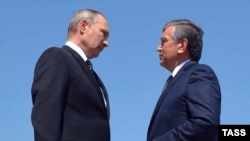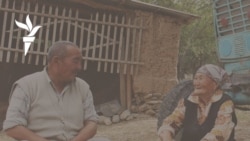
Uzbekistan holds a presidential election on December 4, the fifth such vote in the country’s 25-year history as an independent state. But for the first time, the name Islam Karimov will not appear on ballots.
Karimov’s death, announced on September 2, has given some hope that there could be changes, however slight, to the authoritarian government in Uzbekistan.
RFE/RL assembled our panel podcast, Majlis, to look at the clear front-runner in this weekend's election, what he has done in his brief time as acting president, and discuss the problems he faces in getting the country moving forward after the vote.
Moderating the discussion was RFE/RL Media Relations Manager Muhammad Tahir. Bakhtiyor Nishanov, regional deputy director for Eurasia at the International Republican Institute, participated from Washington. From Prague, Alisher Sidik, the director of RFE/RL’s Uzbek Service, known locally as Ozodlik, joined the conversation. And also from Prague, though from a different studio, I tossed in a few comments.
Shavkat Mirziyaev has been Uzbekistan’s prime minister since 2003. But since September, he has also been interim president, due to what Nishanov described as an “unconstitutional” process that circumvented a constitutional stipulation that should have seen the Senate speaker take over as acting president until an election was held.
Sidik said the December 4 poll is “not about an election, it’s just an approval for current acting President and Prime Minister Shavkat Mirziyaev.”
Mirziyaev’s election as president seems a foregone conclusion, and in that sense the vote mirrors earlier elections won by the late Karimov.
Nishanov noted a small change in the way this latest campaign was conducted. “In the past it was very Soviet-style, 'Go do your duty as a citizen,'” he said, whereas, “This one was a little bit more light-hearted; there were pop artists that would appeal to younger folks.”
Turnout will be important, because Uzbekistan’s second-ever president needs a clear demonstration of his popularity, the enthusiasm of Uzbekistan’s people casting ballots for him.
Mirziyaev is running against three little-known opponents, though two of his rivals in the election -- Khotamjon Ketmonov of the People’s Democratic Party and Nariman Umarov of the Adolat Party -- ran against Karimov in the March 2015 presidential election.
There were numerous accusations of vote rigging in previous elections in Uzbekistan, but those alleged activities were presumably to enhance Karimov’s portion of the vote.
Sidik suggested that, this time, election officials might also have to manipulate the vote count but that, ironically, that might be because Mirziyaev “will get 99 percent; and because they [presumably] don’t want to show that he’s a dictator from the very beginning, they would need to lower his percentage.”
The portion of the vote that Mirziyaev receives might be the only interesting part of the election. A count that shows he received more than 90 percent of the votes could be interpreted as showing he is not confident in his new position and needs a high publicized vote count that speaks to his popularity.
A vote count under 90 or even 80 percent could show Mirziyaev is firmly in power and also would send a message that he and his administration are willing at least to pay lip service to concerns -- expressed mostly in the West -- about Uzbekistan’s commitment to possible democratic reforms.
After the election, Mirziyaev faces some formidable challenges in moving Uzbekistan forward.
“The Uzbek government has got an enormous...problem on their hands, and that’s the economic situation in the country,” Nishanov said.
Sidik noted one of Mirziyaev’s campaign promises has been plans "to attract a lot of investment.”
Where this investment might come from is a big question. China has invested large amounts of money into Uzbekistan, but nearly all it has gone toward projects that bring Central Asian resources to China.
Russia has already signaled it is prepared to invest more money into Uzbekistan. At the end of November, LUKoil proposed building a chain of gasoline stations across Uzbekistan. In the few months that Mirziyaev has been in charge, Russia is virtually the only party that has shown interest in investing in Uzbekistan.
But the Uzbek government has always been wary of getting too close to Russia, and since Mirziyaev assumed power, statements from Uzbekistan have emphasized the country is not interested in joining the Russian-led Eurasian Economic Union (EEU) or the Russian-led Collective Security Treaty Organization (CSTO).
At the same time, Uzbekistan officially has some 1.5 million migrant laborers working in Russia; the actual number could be nearly twice that.
But remittances from Uzbek workers in Russia have fallen drastically, and that has hurt Uzbekistan’s economy. Russia’s central bank reported remittances to Uzbekistan in 2013 of some $6.63 billion; the figure for the first half of 2016 totaled just $952 million.
Eurasian Economic Union member Kyrgyzstan, by contrast, saw its number of migrant laborers increase in 2016 along with the figure for remittances.
Another ostensible postelection plan is to allow the Uzbek national currency, the som, to float. But it was noted that Kazakhstan took that step that in late 2015 and it led to some of the worst social unrest that country had seen since the late 1990s.
Concerning domestic policies on matters like freedom of speech or political pluralism, our Majlis participants voiced doubts about any positive changes.
On freedom of the press, Sidik said: “Mirziyaev never expressed his opinions on this.... He never gave a single interview... never answered journalists’ questions, and I don’t know whether he plans any press conferences.”
It was also noted that Uzbekistan has recently released some political prisoners, which could be taken as a hopeful sign.
Nishanov welcomed these moves but said this was similar to what has been seen previously. “One of the tactics that Karimov had employed was, ‘'We’re going to release somebody [prisoners] and make us look good,’” Nishanov said.
There appeared to be seemingly little hope of change with Mirziyaev as president. But Mirizyaev has hinted that his administration might court better regional ties, and the dire economic situation in Uzbekistan could force his government to make some changes.
There is hope that, as a means to gaining some genuine popularity, Mirziyaev might offer gestures that actually benefit the public, as was true in the first year that Turkmenistan’s second president, Gurbanguly Berdymukhammedov, was in power.
So Mirziyayev will not be a second Karimov; he cannot be. What he might be is further discussed in the Majlis podcast, along with a deeper look at the issues mentioned in this text.
An audio recording of the discussion can be heard at:
Listen to or download the Majlis podcast above or subscribe to Majlis on iTunes.









